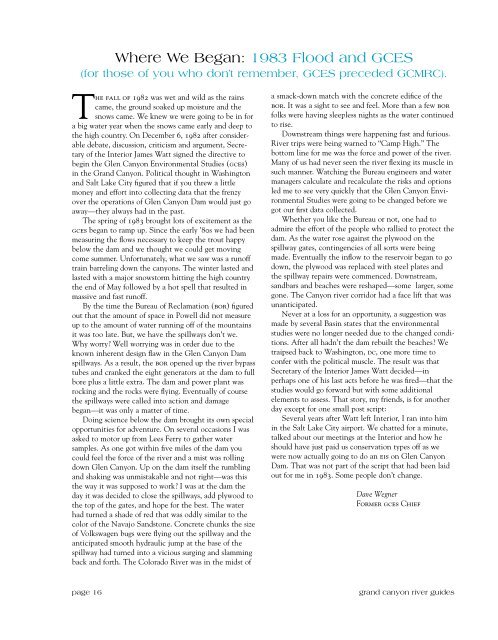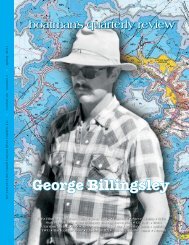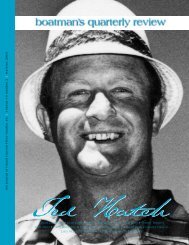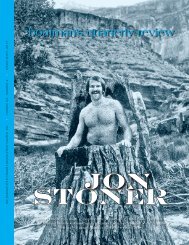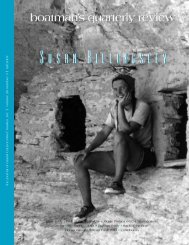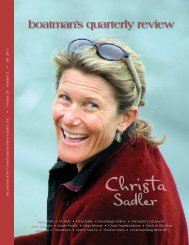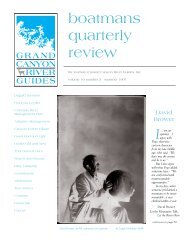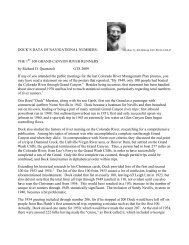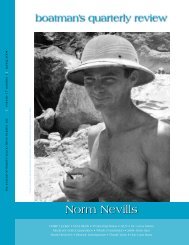boatman's quarterly review - Grand Canyon River Guides
boatman's quarterly review - Grand Canyon River Guides
boatman's quarterly review - Grand Canyon River Guides
Create successful ePaper yourself
Turn your PDF publications into a flip-book with our unique Google optimized e-Paper software.
Where We Began: 1983 Flood and GCES<br />
(for those of you who don’t remember, GCES preceded GCMRC).<br />
The fall of 1982 was wet and wild as the rains<br />
came, the ground soaked up moisture and the<br />
snows came. We knew we were going to be in for<br />
a big water year when the snows came early and deep to<br />
the high country. On December 6, 1982 after considerable<br />
debate, discussion, criticism and argument, Secretary<br />
of the Interior James Watt signed the directive to<br />
begin the Glen <strong>Canyon</strong> Environmental Studies (gces)<br />
in the <strong>Grand</strong> <strong>Canyon</strong>. Political thought in Washington<br />
and Salt Lake City figured that if you threw a little<br />
money and effort into collecting data that the frenzy<br />
over the operations of Glen <strong>Canyon</strong> Dam would just go<br />
away—they always had in the past.<br />
The spring of 1983 brought lots of excitement as the<br />
gces began to ramp up. Since the early ’80s we had been<br />
measuring the flows necessary to keep the trout happy<br />
below the dam and we thought we could get moving<br />
come summer. Unfortunately, what we saw was a runoff<br />
train barreling down the canyons. The winter lasted and<br />
lasted with a major snowstorm hitting the high country<br />
the end of May followed by a hot spell that resulted in<br />
massive and fast runoff.<br />
By the time the Bureau of Reclamation (bor) figured<br />
out that the amount of space in Powell did not measure<br />
up to the amount of water running off of the mountains<br />
it was too late. But, we have the spillways don’t we.<br />
Why worry Well worrying was in order due to the<br />
known inherent design flaw in the Glen <strong>Canyon</strong> Dam<br />
spillways. As a result, the bor opened up the river bypass<br />
tubes and cranked the eight generators at the dam to full<br />
bore plus a little extra. The dam and power plant was<br />
rocking and the rocks were flying. Eventually of course<br />
the spillways were called into action and damage<br />
began—it was only a matter of time.<br />
Doing science below the dam brought its own special<br />
opportunities for adventure. On several occasions I was<br />
asked to motor up from Lees Ferry to gather water<br />
samples. As one got within five miles of the dam you<br />
could feel the force of the river and a mist was rolling<br />
down Glen <strong>Canyon</strong>. Up on the dam itself the rumbling<br />
and shaking was unmistakable and not right—was this<br />
the way it was supposed to work I was at the dam the<br />
day it was decided to close the spillways, add plywood to<br />
the top of the gates, and hope for the best. The water<br />
had turned a shade of red that was oddly similar to the<br />
color of the Navajo Sandstone. Concrete chunks the size<br />
of Volkswagen bugs were flying out the spillway and the<br />
anticipated smooth hydraulic jump at the base of the<br />
spillway had turned into a vicious surging and slamming<br />
back and forth. The Colorado <strong>River</strong> was in the midst of<br />
a smack-down match with the concrete edifice of the<br />
bor. It was a sight to see and feel. More than a few bor<br />
folks were having sleepless nights as the water continued<br />
to rise.<br />
Downstream things were happening fast and furious.<br />
<strong>River</strong> trips were being warned to “Camp High.” The<br />
bottom line for me was the force and power of the river.<br />
Many of us had never seen the river flexing its muscle in<br />
such manner. Watching the Bureau engineers and water<br />
managers calculate and recalculate the risks and options<br />
led me to see very quickly that the Glen <strong>Canyon</strong> Environmental<br />
Studies were going to be changed before we<br />
got our first data collected.<br />
Whether you like the Bureau or not, one had to<br />
admire the effort of the people who rallied to protect the<br />
dam. As the water rose against the plywood on the<br />
spillway gates, contingencies of all sorts were being<br />
made. Eventually the inflow to the reservoir began to go<br />
down, the plywood was replaced with steel plates and<br />
the spillway repairs were commenced. Downstream,<br />
sandbars and beaches were reshaped—some larger, some<br />
gone. The <strong>Canyon</strong> river corridor had a face lift that was<br />
unanticipated.<br />
Never at a loss for an opportunity, a suggestion was<br />
made by several Basin states that the environmental<br />
studies were no longer needed due to the changed conditions.<br />
After all hadn’t the dam rebuilt the beaches We<br />
traipsed back to Washington, dc, one more time to<br />
confer with the political muscle. The result was that<br />
Secretary of the Interior James Watt decided—in<br />
perhaps one of his last acts before he was fired—that the<br />
studies would go forward but with some additional<br />
elements to assess. That story, my friends, is for another<br />
day except for one small post script:<br />
Several years after Watt left Interior, I ran into him<br />
in the Salt Lake City airport. We chatted for a minute,<br />
talked about our meetings at the Interior and how he<br />
should have just paid us conservation types off as we<br />
were now actually going to do an eis on Glen <strong>Canyon</strong><br />
Dam. That was not part of the script that had been laid<br />
out for me in 1983. Some people don’t change.<br />
Dave Wegner<br />
Former gces Chief<br />
page 16<br />
grand canyon river guides


